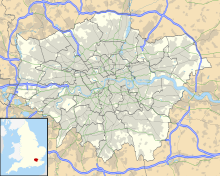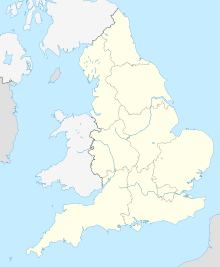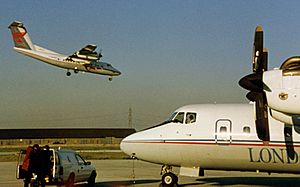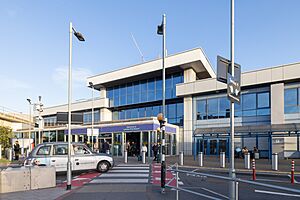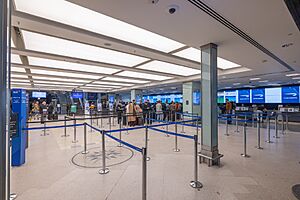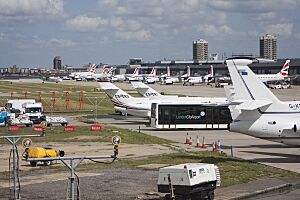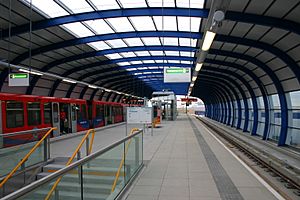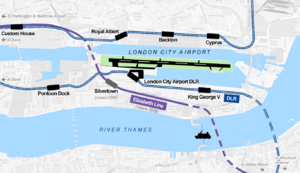London City Airport facts for kids
Quick facts for kids
London City Airport
|
|||||||||||
|---|---|---|---|---|---|---|---|---|---|---|---|
 |
|||||||||||
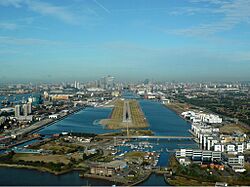 |
|||||||||||
| Summary | |||||||||||
| Airport type | Public | ||||||||||
| Owner | Consortium of AIMCo, OMERS, OTPP and the Kuwait Investment Authority | ||||||||||
| Operator | London City Airport Limited | ||||||||||
| Serves | London | ||||||||||
| Location | Royal Docks, London, England, UK | ||||||||||
| Opened | 26 October 1987 | ||||||||||
| Elevation AMSL | 19 ft / 6 m | ||||||||||
| Coordinates | 51°30′19″N 000°03′19″E / 51.50528°N 0.05528°E | ||||||||||
| Map | |||||||||||
| Runway | |||||||||||
|
|||||||||||
| Statistics (2022) | |||||||||||
|
|||||||||||
London City Airport is an international airport in London, England. It is located in the Royal Docks area, about 6 miles (10 km) east of the City of London. It is also about 3 miles (5 km) east of Canary Wharf. These areas are important financial centers in London. Many business travelers use this airport.
The airport was built by an engineering company called Mowlem between 1986 and 1987. In 2016, a group of companies, mainly from Canada and Kuwait, bought the airport.
London City Airport has one runway that is 1,508 meters (4,948 feet) long. Special rules apply to planes flying here. Only certain types of multi-engine aircraft can use the airport. These planes must be able to land with a steep approach. They also have strict rules about noise. As of 2020, the airport covers about 60 hectares (150 acres).
In 2019, London City Airport handled over 5.1 million passengers. In 2024, it handled 3.57 million passengers. It is the fifth busiest airport serving London. Other busy airports are Heathrow, Gatwick, Stansted, and Luton.
Contents
History of London City Airport
How the Airport Was Planned and Built
The idea for the airport came from Reg Ward in 1981. He was in charge of developing the London Docklands. He talked with Sir Philip Beck from Mowlem, and they thought an airport would be a good idea for the area. By November 1981, Mowlem and Brymon Airways suggested building a small airport for city travel.

To show that the idea was possible, Captain Harry Gee landed a de Havilland Canada Dash 7 plane on Heron Quays in 1982. This area was part of the West India Docks. After this, a study showed that building the airport was possible. A survey also found that most local people supported the idea. Mowlem then asked for permission to build the airport.
A long public meeting about the plans started in June 1983. In 1985, permission to build the airport was finally given. The airport site was about 92 acres (37 hectares) in size.
Construction started soon after. Charles, Prince of Wales laid the first stone for the terminal building in May 1986. The first plane landed on May 31, 1987. Commercial flights began on October 26, 1987. Queen Elizabeth II officially opened the airport in November of that year.
Opening and Runway Changes
In 1988, the airport's first full year, 133,000 passengers used it. Early flights went to places like Plymouth, Paris, Amsterdam, and Rotterdam. The runway was only 1,080 meters (3,540 feet) long. Also, planes had to land at a steep 7.5-degree angle to reduce noise. Because of this, only a few types of planes could use the airport, like the Dash 7. In 1989, the airport asked to make the runway longer.
In 1990, 230,000 passengers used the airport. But numbers dropped after the Gulf War. They did not recover until 1993. By then, the longer runway was approved and opened on March 5, 1992. The landing angle was also made less steep, at 5.5 degrees. This allowed more types of planes to use the airport, such as the BAe 146 and Airbus A318.
By 1995, passenger numbers reached half a million. In 2002, a special area for private jets was opened. More parking spots for planes were also added. In 2003, a new holding point was made at the end of the runway. This allowed planes to wait there while others landed.
More Airport Growth
On December 2, 2005, the London City Airport DLR station opened. This gave the airport its first train connection. It linked the airport to Canary Wharf and the City of London. By 2006, over 2.3 million passengers used the airport.
In October 2006, a group of companies bought the airport. In 2008, the airport got permission to build more parking stands for planes. These new stands were built over the water of the King George V Dock.
British Airways started the first regular flights across the Atlantic Ocean from the airport in September 2009. These flights went to New York City's John F. Kennedy International Airport. They used a special Airbus A318 plane.
London Olympics 2012
Before the 2012 Summer Olympics in London, over £7 million was spent to improve the terminal. During the Games, the airport had strict rules and limited hours for security reasons. However, it was the closest airport to the Olympic Park.
Current Expansion Plans
In early 2013, work began on a £15 million project. This project aimed to improve the western part of the terminal with new gates and lounges. It also improved the international arrivals area and baggage handling. The airport has a plan for growth until 2030. This plan aims for the airport to handle 8 million passengers each year. It does not include building a second runway.
The first part of this plan included extending the apron (where planes park). It also added a pier for passengers to reach planes. The terminal building was also made bigger. A new hangar for plane maintenance was built.
Later parts of the plan include building more plane parking spots. A taxiway was also built next to the runway. This helps planes move around without blocking the runway. The fuel storage area was moved to the east of the airport. It can now get fuel by barge, reducing road deliveries. The car park was replaced with a multi-storey car park. This allowed more space for dropping off and picking up passengers. The old terminal building will also be replaced in the future.
In August 2007, London City Airport asked for permission to increase flights from 80,000 to 120,000 per year by 2010. After some discussions, the plan was approved in February 2015. However, the Mayor of London, Boris Johnson, overturned this decision in March 2015. On July 27, 2016, the airport finally got approval for its £344 million expansion plan.
Recent Changes
In October 2015, the airport was put up for sale. A group of Canadian-led companies bought it for £2 billion in February 2016. The sale was completed on March 10, 2016.
In September 2016, British Airways stopped one of its daily long-haul business flights to New York City. They said it was for economic reasons. In March 2020, British Airways stopped its daily service to New York due to the COVID-19 pandemic. In September 2020, the airline confirmed the service would not return.
In November 2020, a new parallel taxiway and eight more aircraft parking stands became active. These were built on a concrete platform over the King George V Dock.
In January 2021, London City Airport became the first major airport to be controlled by a remote air traffic control tower. The control tower was moved 80 miles away to Swanwick, Hampshire. Controllers use live video to guide planes.
In July 2023, the runway's operating distances were updated. This followed the addition of special safety systems at each end of the runway. Plans were approved to increase the number of passengers the airport can handle from 6.5 million to 9 million. This also allows more morning flights between 6:00 AM and 9:00 AM.
On March 26, 2025, an Embraer E195-E2 plane landed at London City Airport for the first time. This is the largest certified aircraft at the airport.
Airport Operations
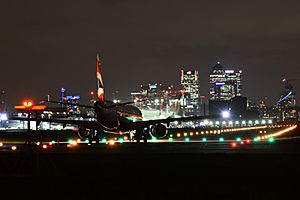
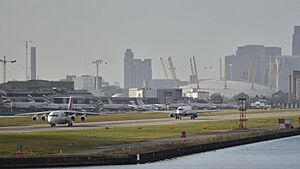
Where Planes Fly From London City
London City Airport is close to London's financial areas. So, many business travelers use it for flights to places like Luxembourg and Frankfurt. However, more leisure destinations like Palma de Mallorca, Málaga, and Chambéry have been added recently. The airport is busiest in winter. Airlines like British Airways and Swiss International Air Lines fly to ski destinations. Zürich, Geneva, and Milan are popular for winter sports.
Airport Facilities and Aircraft Types
The airport has strict rules to limit noise because it is close to Central London. The runway is 1,508 meters (4,948 feet) long, and planes land at a steep angle. These factors limit the types of aircraft that can use the airport. The airport can get very busy during peak hours. Air traffic controllers handle over 38 flights per hour.
The airport has specific operating hours:
- Monday to Friday: 6:30 AM to 10:30 PM
- Saturdays: 6:30 AM to 1:00 PM
- Sundays: 12:30 PM to 10:30 PM
These hours are set to control noise. In December 2022, the airport asked to remove the Saturday afternoon restriction. However, this was rejected in July 2023 due to noise and environmental concerns.
Many mid-range airliners use London City Airport. These include the ATR 42, ATR 72, Airbus A318, Bombardier Dash 8 Q400, BAe 146/Avro RJ, Dornier 328, Embraer ERJ 135, Embraer 170, Embraer 190, and Fokker 50. The Airbus A220-100 was certified for the steep approach in April 2017. In 2023, Airbus confirmed they are working on certifying the larger A220-300 for the airport.
Private jets like the Beechcraft Super King Air, Cessna CitationJet series, and Dassault Falcon jets are also common. Single-engine planes and helicopters are not allowed. Recreational flights are also not permitted. In 2025, the airport applied for approval for the larger Airbus A320neo to operate there.
The airport is surrounded by the Royal Albert and King George V docks. This means there are no covered facilities for aircraft maintenance.
Terminal Building
London City Airport is smaller than other London airports like Heathrow or Gatwick. This is because space is limited in East London. The airport has one two-story terminal building with 18 gates. All gates are hardstands, meaning passengers walk to the planes.
The ground floor has check-in desks and services. Stairs lead to security control on the upper level. After security, there is a waiting area with shops. This waiting area connects to piers on both sides. Corridors on the upper floor lead to the departure gates on the ground level. The airport does not have jet bridges, so passengers always walk to board their planes.
Airlines and Destinations
The following airlines fly regularly to and from London City Airport:
| Airlines | Destinations |
|---|---|
| Aurigny | Guernsey |
| British Airways | Amsterdam, Belfast–City, Berlin, Dublin, Edinburgh, Florence, Frankfurt, Glasgow, Ibiza, Madrid (resumes 1 December 2025), Málaga, Milan–Linate, Palma de Mallorca, Rotterdam/The Hague, Zürich Seasonal: Barcelona, Bergerac, Chambéry, Faro, Geneva, Nice, Olbia, San Sebastián, Skiathos, Split, Thessaloniki |
| ITA Airways | Milan–Linate, Rome–Fiumicino |
| KLM | Amsterdam |
| Loganair | Isle of Man |
| LOT Polish Airlines | Vilnius |
| Lufthansa | Frankfurt |
| Luxair | Luxembourg |
| Swiss International Air Lines | Zürich Seasonal: Geneva |
Airport Statistics
Passenger Numbers
The number of passengers at London City Airport grew quickly between 2003 and 2008. It doubled from about 1.5 million to over 3 million per year. Numbers dropped in 2009 and 2010 but then recovered. In 2019, over 5.1 million passengers used the airport. In 2020, passenger numbers fell sharply to under 1 million due to the COVID-19 pandemic.
| Year | Passengers ‡ | Movements † | ||
|---|---|---|---|---|
| 1997 | 1,161,116 | 34,605 | ||
| 1998 | 1,360,187 | 39,078 | ||
| 1999 | 1,385,965 | 44,376 | ||
| 2000 | 1,583,843 | 52,643 | ||
| 2001 | 1,618,833 | 57,361 | ||
| 2002 | 1,602,335 | 56,291 | ||
| 2003 | 1,470,576 | 52,856 | ||
| 2004 | 1,674,807 | 61,029 | ||
| 2005 | 1,996,397 | 71,105 | ||
| 2006 | 2,377,318 | 79,436 | ||
| 2007 | 2,928,820 | 91,177 | ||
| 2008 | 3,271,716 | 94,516 | ||
| 2009 | 2,802,296 | 76,861 | ||
| 2010 | 2,793,813 | 68,640 | ||
| 2011 | 3,009,783 | 68,792 | ||
| 2012 | 3,030,005 | 70,781 | ||
| 2013 | 3,390,264 | 74,006 | ||
| 2014 | 3,702,032 | 76,260 | ||
| 2015 | 4,319,749 | 84,753 | ||
| 2016 | 4,526,059 | 85,169 | ||
| 2017 | 4,511,107 | 80,490 | ||
| 2018 | 4,800,190 | 78,036 | ||
| 2019 | 5,100,025 | 80,751 | ||
| 2020 | 905,326 | 18,850 | ||
| 2021 | 713,969 | 12,921 | ||
| 2022 | 2,990,201 | 44,731 | ||
| 2023 | 3,412,122 | 52,101 | ||
| 2024 | 3,569,871 | |||
| Source: UK Civil Aviation Authority | ||||
‡ Includes both domestic and international passengers.
† Total aircraft takeoffs and landings.
Busiest Routes
| Rank | Airport | Total passengers |
Change 2020–2021 |
|---|---|---|---|
| 1 | Amsterdam | 393,748 | |
| 2 | Edinburgh | 304,035 | |
| 3 | Zurich | 293,822 | |
| 4 | Frankfurt | 226,711 | |
| 5 | Dublin | 206,945 | |
| 6 | Luxembourg | 181,670 | |
| 7 | Glasgow | 176,763 | |
| 8 | Berlin | 136,281 | |
| 9 | Belfast–City | 121,502 | |
| 10 | Düsseldorf | 118,997 |
Getting To and From the Airport
Docklands Light Railway (DLR)
London City Airport has its own DLR station. It is an elevated station right next to the terminal building. The Docklands Light Railway connects the airport to Canary Wharf and the City of London. You can also reach Stratford International and Woolwich Arsenal stations. From there, you can connect to other train services like the London Underground and Elizabeth line.
Elizabeth Line
The Elizabeth line opened in May 2022. It passes very close to the airport, about 300 meters (980 feet) to the south. However, there is no Elizabeth line station directly at the airport.
Road Access
The airport is connected by the A1020 road and the A112 road. These roads provide quick links to nearby areas like Canning Town and Stratford. They also connect to major roads like the A13 and the North Circular Road, London (A406). The airport has both short-term and long-term car parks close to the terminal. There is also a taxi rank outside the terminal.
Local Buses
Several London Buses services stop at the airport.
River Bus
Thames Clippers river bus services stop at a pier nearby. This allows you to travel into Central London using an Oyster card or contactless smart card.
Accidents and Incidents
- On February 13, 2009, a BA CityFlyer plane (an Avro RJ100) had a problem with its nose landing gear while landing. None of the 67 passengers or five crew members were seriously hurt. Three passengers had minor injuries. The plane was too damaged to be repaired.
- On October 21, 2016, an incident involving a substance caused 27 people to be injured. Many flights were cancelled, causing delays for thousands of passengers. Police later confirmed that bottles of a substance had been placed to cause harm or disruption. Security was increased at the airport after this event.
See also
 In Spanish: Aeropuerto de la Ciudad de Londres para niños
In Spanish: Aeropuerto de la Ciudad de Londres para niños
- List of airports in the United Kingdom and the British Crown Dependencies
- Airports of London


